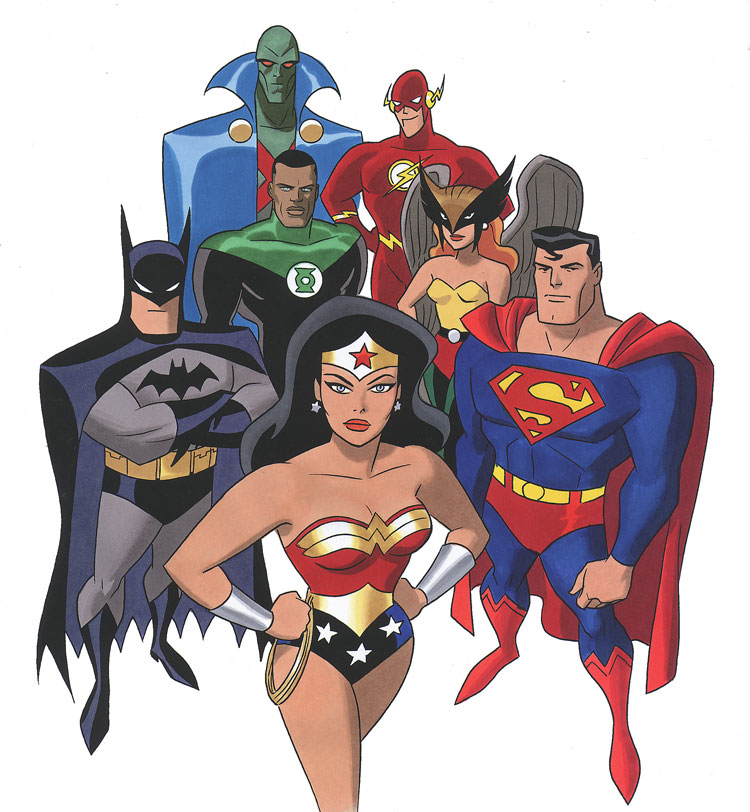Justice League/Justice League Unlimited (2001-2006)
Executive producer Bruce Timm is the first to admit that for a long time he avoided the idea of a Justice League series because of the difficulty of having to focus on so many characters. “All the shows we’d done were one-character shows that would occasionally have guest stars or sidekicks,” he reflects. “But even those shows were a hint of things to come in that every time we had an episode with Batman and Robin or Batgirl, just in staging the action scenes, it was difficult to do.”
That difficulty, he explains, came from the idea of keeping all of the characters in motion at the same time. In other words, if too much time is spent on Batgirl fighting someone, the audience is asking, “What’s Batman doing?”, so there is a need to then cut to Batman. Naturally at that point, the audience is then asking, “What’s Batgirl doing?”
“It’s an extra problem that makes the storytelling a little more difficult,” agrees Timm. “Suddenly, with the Justice League, you have to keep seven characters in motion, and they all have fantastic: powers.”
Eventually, Cartoon Network decided it wanted a Justice League series, and Timm and his team – including producers James Tucker and Rich Fogel and story editors Stan Berkowitz and the late Dwayne McDuffie – set about trying to come up with a team dynamic, attempting to choose who would be appropriate for the series and how they would relate to each other. In the end, and despite the fad that a number of heroes were considered for the line-up, the final members of the Justice League were Superman, Batman, Wonder Woman, the Martian Manhunter, Green Lantern (John Stewart), the Flash and Hawkgirl.
“There wasn’t a whole lot of arguing going on,” explains Timm. “We all decided very quickly and easily on the line-up, and from that point on it was just a matter of sitting down, talking about the characters and saying, These are who we’re going to use. What do they do? What about their characters informs the way they act?’ Basically we wanted to keep the show to the core seven in the first two seasons. We wanted to keep it limited, because the majority of the episodes didn’t have all seven of them in it; there were just too many damn characters. They won’t get enough screen time to make an impact if there are seven of them every single episode. Somebody would have to be Chekov. Somebody would be saying, ‘Hailing frequencies open, Captain.’ So we always had to pare it down.”
Fogel points out that part of the challenge was that the characters making up the Justice League were not originally designed to go together. “They had their own origins, their own universe and their own lives,” says Fogel, “It wasn’t like the Fantastic Four, where those characters were designed specifically to go together. If you look at the early Justice League comic-books, they threw them together without much attention to detail, and everybody ended up being the sort of generic good guy. There was no personality, no dynamic between them. So one of the big challenges we had in the first season was, ‘We’re putting this group together, what niche are they going to fill?’ As we moved into the second season, we were able to get more facets and shades of grey into their characters and approaches.”
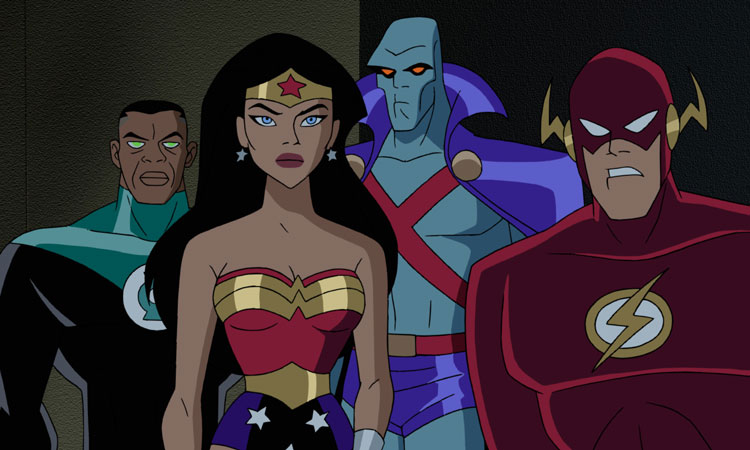
Tucker points out that virtually every decision made in the development of Justice League was driven by Timm’s philosophy that the creative team was not working on a cartoon, but that they were labouring on a stylised live-action show.
“Our thoughts going in [were] basically ‘We can do what live action can’t because of the budget,” he says. “But we didn’t go in there thinking it’s totally unrealistic or cartoony, for lack of a better word. We treated it as though it’s live action, so we tried to come up with staging and actions that a real person could do if they had superpowers.”
But it wasn’t easy, as Fogel emphasises; “I don’t think people understand that doing Justice League, even though it was part of the DC Universe, was a whole different kettle of fish than doing Batman or Superman. There you’re dealing with one hero in what is essentially a realistic universe where they have secret identities and regular people on the street. As soon as you have a whole group of superpowered characters running around, it sort of shifts the spectrum. Finding a way to make that so it’s palatable and acceptable to a mainstream audience was really hard work. You really need to find those human aspects of those characters so that people can care about them and can relate to them.”
Those aspects were most definitely found in Seasons One and Two, but then the writers were presented with a whole new set of challenges when it came to Season Three and the show’s new name, Justice League Unlimited. Running for three seasons, it represented a shift from multi-part storylines to standalone, with an additional proviso from the network calling for the series to somehow be ‘rebranded’ to signify that there was something new about it. The result: rather than being limited to a group of seven heroes, the doors to the DC universe were blown wide open for the show’s creators to pick and choose. “For the most part, the episode roster changed from episode to episode. Some of the episodes had a lot of the ‘old school’ Justice Leaguers from the big seven, and some of them had maybe one,” says Timm.
Enthused McDuffie at the time: “We know how Superman and Batman are going to react to each other. We don’t know how Superman and Green Arrow are going to react to each other, so you got to see a different piece of the characters that you think you know really well. That was an advantage. Also, sending the team off in different groups meant we can use different kinds of villains and have different kinds of threats. It doesn’t always have to be the end of the world; it can be a smaller problem with much bigger personal stakes for the characters. And it gave us a chance to bring to life in animation characters who we otherwise probably would never see.”
While creatively the new format was freeing, Timm believes it was extremely challenging for the writers as well. “Even though all of these characters have comic-book history as long as your arm,” he says, “we still had to sift through that and redefine for ourselves what we want those characters to be. Each one of them has radically different personalities depending on who’s writing the book. Kind of what we did with Batman when we did the series; what is it about Batman that we like out of all the different versions? What says Batman to us? So the same thing happened whenever we were dealing with one of these other heroes. If we bring something new, we want to make sure that it’s something true to the spirit of the character. It’s fun. It’s like starting with a palette of seven colours and suddenly being given a palette of unlimited colours.”
Justice League Unlimited ended its run with the perception held by many that it represents the best televised efforts of the DC Tooniverse produced to date.
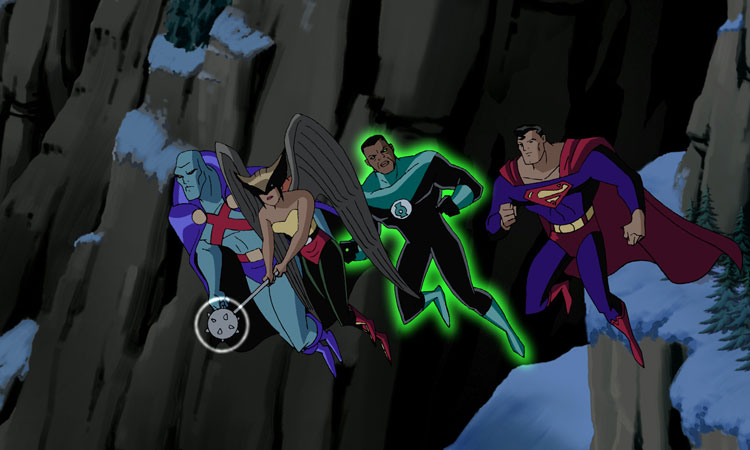
Justice League New Frontier (2008)
Based on the graphic novel by Darwyn Cooke, Justice League: The New Frontier, which is set in the early Sixties, chronicles the League’s first coming together and their overcoming of fear and suspicion to forge an alliance against a creature so formidable that even Superman can’t stop it alone.
“I think one of the reasons that The New Frontier is so appealing is because the villain is so strong and so weird and so different from everything else,” says Berkowitz. “It’s a really good threat. I’m referring, of course, to the character known as The Center. It’s unique. Where else have you seen a villain that looked like an island? That can think and has been around since the beginning of time? That was motivated by anything but paranoia in the movie? In the graphic novel he’s motivated by a desire to see the stars and to kill humanity. In the movie the motive is simplified to the point where he is simply afraid of the humans because they’re developing atomic power. He’s a super intellect and you can relate to him on a human level. He’s scared; he’s been around for a long time and he doesn’t want his run to end.”
Also appealing for executive producer Gregory Noveck was the thing that inspired Cooke in the first place: President Kennedy’s ‘New Frontier’ speech following his election: “What’s amazing between the two is that the issues remain the same today,” he offers.
“We’re still dealing with cultural repression, oppression, racism, fear from abroad and poverty – all of these things that Kennedy spoke about in that speech are so relevant and so real. They all transformed in some way, and that to me makes it so evocative. The best science fiction is always a parable. I think New Frontier has that same effect. It’s the disillusioned war veteran trying to come to peace with what it meant to be a warrior after battle and finding that he still has some heroism left. The Flash realising he doesn’t need public approval to do what he does, because he has a responsibility. The icon – Superman – all of a sudden seeing that what he is being held up to represent is rotten to the core. And ultimately it’s the birth of something greater. There are problems in society, but there’s still something laudable and honourable about the people in it. All of these themes and storylines are relevant, And besides the story itself, the film just looks cool.”
Justice League: Crisis On Two Earths (2010)
Lex Luthor arrives from an alternate universe to recruit the Justice League to help save his Earth from the Crime Syndicate, a gang of villainous characters with virtually identical superpowers to the Justice League. What follows is the ultimate battle between good and evil in a war that threatens both universes, and through a plan launched by the Batman-alike Owlman, puts the balance of oil existence in peril.
“There are so many different continuities for all of the characters in the comics over the many years that we’re sort of used to seeing Batman and Superman in different contexts, which is fun,” said McDuffie, “but a lot of it, in this particular case, is seeing what the world would be like if they weren’t good people. They have enormous power and there are almost no checks on their power. You’ve got Owlman instead of Batman, Ultraman instead of Superman, and Super Woman instead of Wonder Woman. They’re completely different people who have chosen to use their power for personal gain.
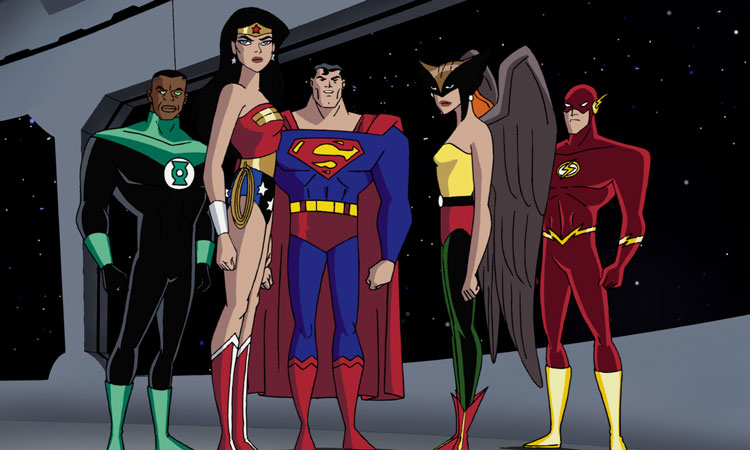
“For me, probably the most interesting part about this is the rift between Batman and the rest of the group about the responsibilities of the Justice League on our Earth,” he continues. “Our Justice League immediately charges over to the parallel Earth to help out, and Batman stays here, because he feels his primary mission is to protect the world he lives in. That was interesting.”
Justice League Doom (2011)
If knowledge is power then Batman must be the most powerful being on Earth, as he has discovered the weaknesses of each member of the Justice League – including Superman, Wonder Woman and Green Lantern – and developed a plan to use them against his teammates if they ever go rogue. As the animated adventure Justice League: Doom unfolds, that information has reached enemy hands and is being used against the group.
“When the Justice League finds out that he has actually done this and a villain has taken over his plans and put them into motion against them, they feel, quite rightfully, betrayed by Batman,” says Timm, ‘That’s the interesting story gimmick and the emotional gimmick of the story – it’s that argument that they say to Batman, ‘How can you do this to us?’ And he’s like, ‘How could I not do this? You guys are the most powerful people on the planet. If you ever get mind-controlled or went evil for whatever reason, you bet your ass I’m going to have a back-up plan to lake you down.” It’s always the best drama when you have two characters who have completely different viewpoints and are at odds with each other, and they’re both right.”
Justice League: The Flashpoint Paradox (2013)
For some fans who have been following the animated films, there is a growing frustration over the fad that the vast majority of the flicks centre around Batman or Justice League, and then Superman, with many other characters not getting the same kind of opportunity to be featured. Of course there have been attempts, most notably with Wonder Woman, Green Lantern and even the collection of short films, DC Showcase, but the resulting sole figures didn’t support the idea of such forays. Tucker, who has taken over as producer of the line from Timm, believes that there’s a creative way around this particular challenge, which is nicely represented in Justice League: The Flashpoint Paradox. In the film, the Flash travels back in time to change an event in his personal history, resulting in a rippling after-effect that changes everything, including the fates of Superman and Batman, and brings the world to the verge of an apocalyptic battle waged between Aquaman and Wonder Woman.
“I can’t think of any other classic DC stories that I want to adapt, and I’m not big of adapting stuff anyway,” Tucker admits. “Once you’ve done The Dark Knight Returns, that’s the ultimate DC adaptation. So my attitude is: ‘OK, this leaves me open to doing interpretations of characters and stories,’ so what we did with Flashpoint is kind of change the dynamic a little bit. Doing things that are based on characters and situations from the comics, but not literal adaptations. They’ll be more like original stories along the lines of what we did with Green Lantern: First Flight and Wonder Woman. There won’t be as many literal adaptations. That’s a step in the right direction, because this is a Flash focused story, and it’s probably the only Flash-focused story that would sell, because there is a version of the Justice League involved.”
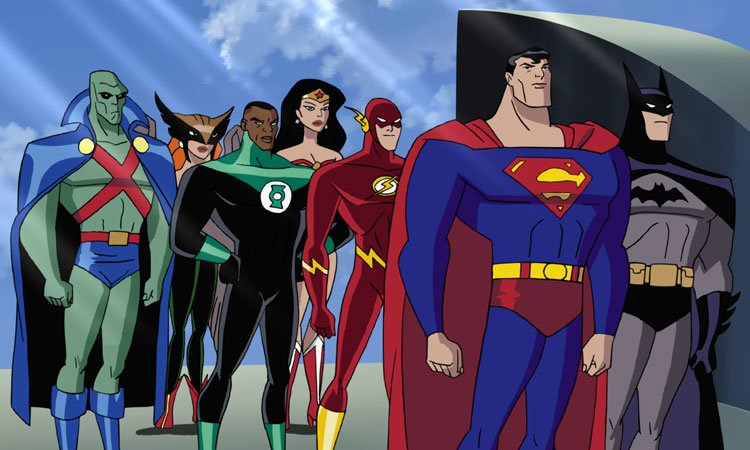
An intriguing aspect of the film is that it’s the first that doesn’t focus so much on superhero and supervillain battles as it does on a worldwide war featuring these characters. “That was a thrill,” enthuses writer Jim Krieg, “I love all of the superhero tropes, but there was something kind of heady and a little bit intoxicating to take all of that stuff, crumple it up and throw it over my shoulder and say, ‘Now it’s war!’ And what does war look like with these people? One word: bad. War looks bad anyway with regular people, but it’s even worse in a weird way because we care about these made up characters.”
Adds director Jay Oliva: “One of the problems I have whenever it’s written in a, ‘all hell breaks loose,’ or ‘epic fight here’ as a storyboard artist or director I just want to rip my hair out, because it leaves it open. One of the things I wanted for the end battle was a Saving Private Ryan feel. When the tanks come at the end of Flashpoint, I wanted London to have a demolished landscape. If you look at the film, there are little touches you see of British tanks and crashed planes, and you get the idea there was a battle before the Battle of London, I liked that idea, so when these two armies end up clashing in the third act, I wanted to have a very different feel from what we’d gotten earlier where we were in Gotham and Metropolis, I said: ‘You want to see what London looks like after the Amazons move in? This is how it looks.’”
Justice League: War
Set in the world of DC’s New 52, Justice League: War is inspired by the first JL arc written by Geoff Johns and drawn by Jim Lee. As things unfold, the members of the League meet for the first time and have to learn to work together while fighting Darkseid and his minions.
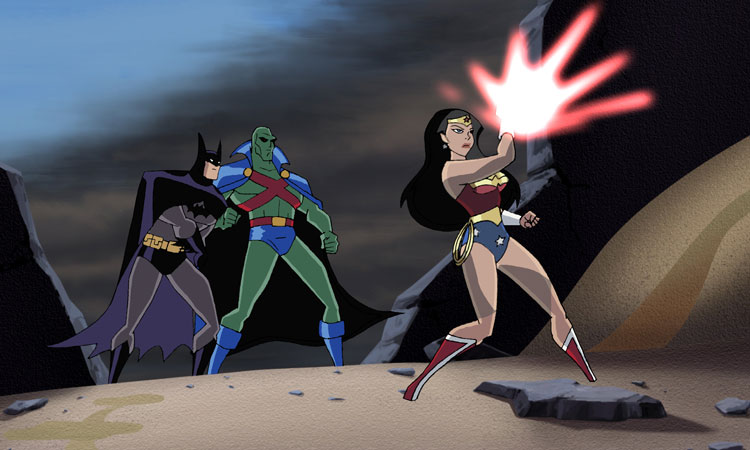
“My take was basically The Breakfast Club with superheroes,” laughs writer Heath Corson, “These are guys who are meeting each other for the first time; these are people who have maybe seen or heard of each other. The world is just starting to know about them. What if they had no idea about each other, what they’re capable of, what they’ll do, what they can do? These are guys in their 20s and, let’s be honest, a 25-year-old Green Lantern is a douche. He’s a frat boy. And then you rub him against Batman, who’s a little introverted to say the least, and you’ve got something there. Superman is really a super alien. He’s a bruiser. He’s not the boy scout. He’s the guy who knows how to talk with his fists, so in this we’re really leaning on the fact that he’s not the one saying we should do the right thing. He’s the one floating five feet above the ground with his arms crossed and his eyes glowing red. Once all of these voices and dynamics got locked in, it was super fun to play with these guys.”
“When they first meet up, they do fight the villains in the movie, they’re getting in each other’s way,” elaborates returning director Oliva, who also served as storyboard artist on Man Of Steel. “There’s no teamwork whatsoever until the very end when they start to work together and become the start of what they will eventually be. I think what this story’s about is really the coming together of all of these strong personalities, and the birth of new hero, which is Cyborg, and thrown in the mix is Darkseid. I will say one thing about that final battle between the Justice League and Darkseid: wait until you see Wonder Woman go off on him. It’s beautiful!”
This article was written in 2013. The most recent addition to the DC animated universe was Batman: Soul of the Dragon (read our review) and the next addition will be Justice Society: World War II. Keep it SciFiNow for interviews with Justice Society: World War II‘s writer Jeremy Adams and stars Matt Bomer and Elysia Rotaru.
